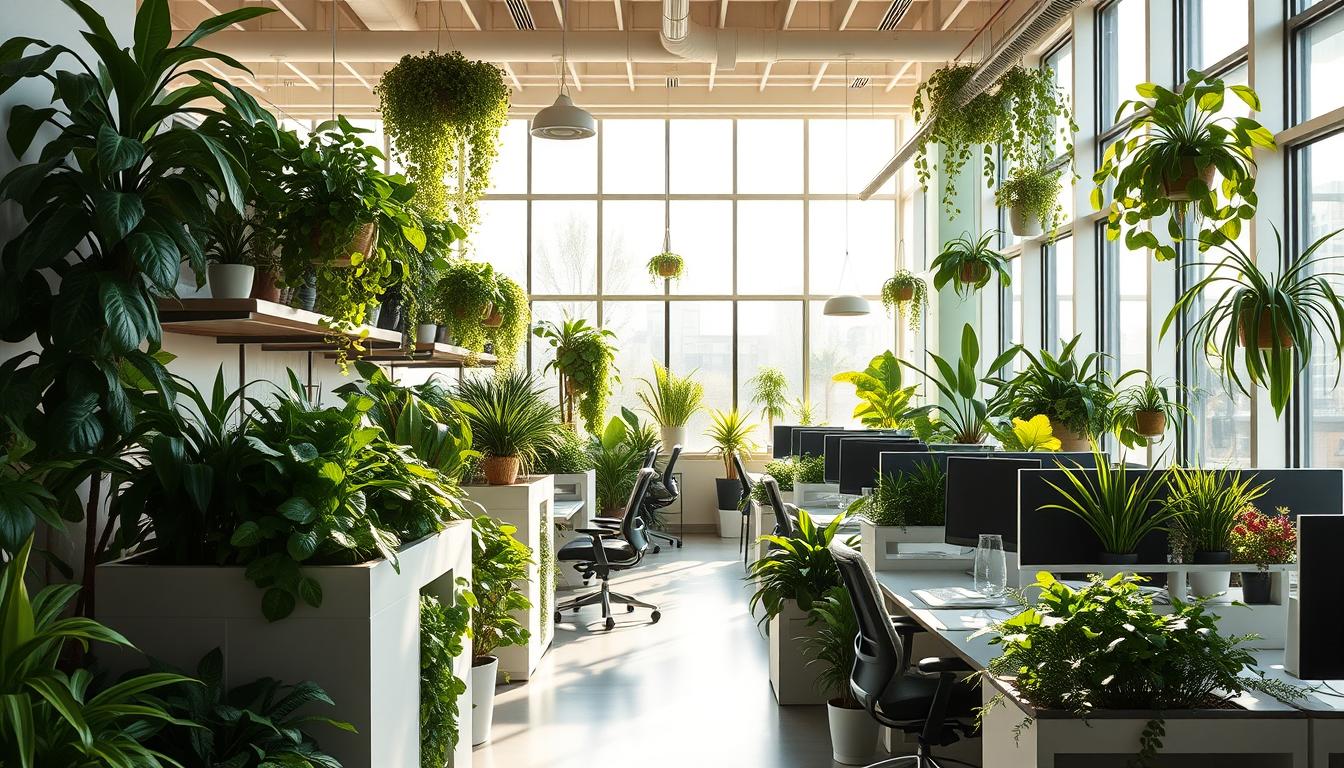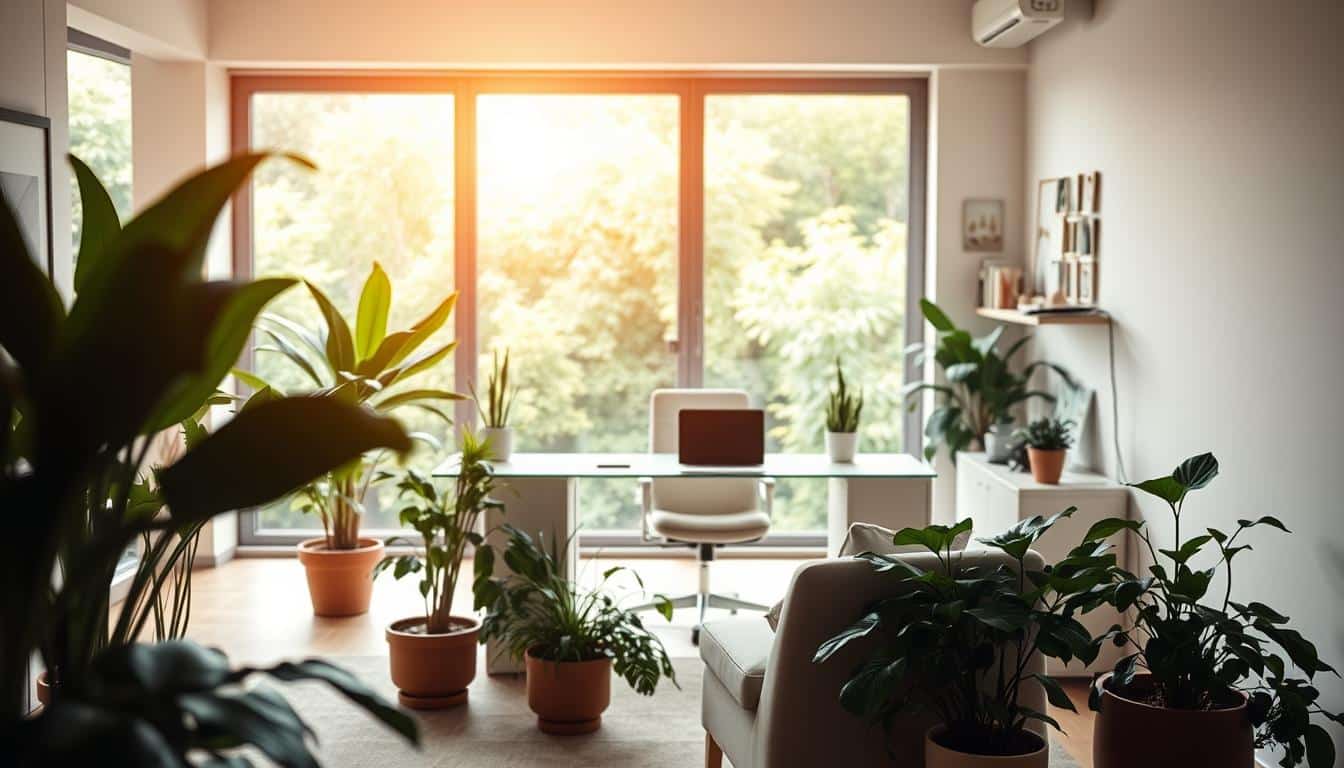Now more than ever, improving air quality is crucial. A lot of us spend most time indoors. It’s vital to grasp how plants can cleanse the air we breathe. Through this process, plants offer big health perks for those in homes or offices.
Houseplants do more than make spaces look nice. They are key in cleaning the air inside. This process is backed by science. By adding plants to our rooms, we help tackle indoor air pollutants. This boosts the health of individuals and families.
Introduction to Air Quality Issues
Indoor air quality is getting more attention because cities’ air problems are on the rise. Most people living in cities stay indoors up to 90% of the time. So, it’s very important to know how it affects our health. Bad air quality inside can cause health issues like breathing problems, asthma, and allergies.
Many things inside our homes and workplaces can pollute the air. This includes cleaning products and building materials. Also, not having enough fresh air in places where we live and work makes it worse. This can lead to more health problems for people in cities. Therefore, we must focus on finding new ways to improve air quality.

Understanding Indoor Air Pollution
Many people are inside most of the time. This makes indoor air pollution a big worry. We need to know where indoor air pollution comes from to fix air quality problems. Things like volatile organic compounds and tiny particles in the air can harm our health.
Common Sources of Indoor Pollutants
There are many common things that make indoor air dirty. These include:
- Volatile organic compounds (VOCs) come from products like paints, glues, and cleaners.
- Tiny particles are made when we cook, heat our homes, or use certain building materials.
- Older building materials can release asbestos, which is very harmful.
- Household sprays and pesticides add chemicals to our indoor air.
Health Impacts of Poor Indoor Air Quality
Pollutants can make us really sick and affect how well we feel. Being exposed to dirty air indoors can lead to:
- Breathing problems like asthma and long coughs from particle exposure.
- VOCs can cause headaches and make us feel very tired.
- Being around dangerous materials for too long can even cause cancer.
What is Plant-Mediated Air Detoxification?
Plant-mediated air detoxification is how plants clean the air by taking in pollutants. This method is key to making indoor air pure and helping the environment. In this, plants play a major role by using phytoremediation. This is when plants remove, change, or trap harmful substances in the air.
Plants use their leaves and roots in complex ways to clean the air. They can take in harmful gases and break them down. This process doesn’t just lower pollution. It also makes more oxygen available indoors. Over time, many plants have evolved to be great at cleaning the air in polluted places.
Adding plants indoors brings beauty and cleans the air around us. This shows the strong link between nature and our health. By using natural air purifiers, we get to breathe better and live healthier.
Types of Pollutants Targeted by Houseplants
Houseplants are recognized for their role in reducing indoor air pollutants. They mainly focus on two types: Volatile Organic Compounds (VOCs) and Particulate Matter (PM). Knowing how these plants help clean the air makes them more effective for indoor use.
Volatile Organic Compounds (VOCs)
VOCs are organic chemicals that can turn into gas at room temperature. They are common in products like paints, cleaners, and furniture. Formaldehyde and benzene are well-known VOCs that can harm health if breathed in for too long. Plants that remove VOCs work well to take in these dangerous substances, naturally making the air better.
Particulate Matter (PM)
Particulate matter is made up of small particles floating in the air. They come from things like burning stuff, dust, and allergens. These particles can get deep into your lungs, causing breathing problems. Some plants are great at lowering PM levels. They do this by catching particles on their leaves or absorbing them through their roots. These plants are excellent for improving the quality of indoor air.
Scientific Evidence Supporting Plant-Mediated Detoxification
Many studies have looked deeply into how plants can improve air quality. Breakthroughs from NASA’s air quality studies prove some houseplants can clean the air in tight spaces. This research shows plants play a crucial role in making indoor spaces healthier by reducing air pollution.
NASA Studies on Air Quality
In the late 1980s, NASA started important tests on air quality in space stations. They tested various houseplants to see how well they can remove harmful compounds from the air. Their research found that plants like the spider plant and peace lily are good at taking in pollutants and making the air better.
Recent Phytoremediation Research
New research on phytoremediation shows how plants break down toxins in the environment. Recent studies have found certain plants do well in cities, cleaning harmful substances naturally. This information proves plants are a natural way to enhance air quality, important for sustainable cities.
Health Benefits of Improved Air Quality through Plants
Plants can significantly enhance indoor air quality, offering major health benefits. These well-chosen houseplants clean the air. They also make living environments healthier, leading to better air quality health benefits.
Reduction in Respiratory Issues
Plants help reduce respiratory problems significantly. They filter out harmful pollutants like volatile organic compounds (VOCs) and particulate matter. This creates a safer environment that lowers the risk of allergies, asthma, and other lung diseases.
Studies have found that greenery helps decrease the risk of respiratory ailments. This supports overall lung health.
Enhancement of Cognitive Function
Improved air quality through plants also boosts cognitive functions. Research shows that plant-enriched environments boost concentration, creativity, and productivity. Plants in indoor spaces lift mood and improve cognitive performance. This makes plants vital for work and learning spaces.
Best Houseplants for Air Detoxification
Picking the right houseplants can make indoor air cleaner. Some plants are really good at taking out bad stuff like chemicals and tiny particles from the air. Here are the top plants for cleaning the air, especially because they can detoxify it.
High-Performing Species for VOC Removal
Bad chemicals, known as VOCs, can harm your health. The plants listed below are great at cleaning the air indoors:
- Spider Plant: Tough and efficient, the spider plant sucks up many kinds of pollutants. It’s a great option for cleaner air.
- Peace Lily: Pretty and powerful, the peace lily gets rid of dangerous chemicals like benzene and formaldehyde.
- Golden Pothos: Easy to take care of and good at purifying air, golden pothos works well in different settings.
Plants Effective in Reducing Particulate Matter
Tiny particles in the air can make breathing problems worse. These plants are good at keeping the air healthier:
- Rubber Plant: Great for removing particles, the rubber plant can get big and really improve air quality.
- Dracaena: Different types of dracaena can catch tiny particles, perfect for homes or offices.
- Areca Palm: This palm adds moisture to the air and controls particle levels, making indoors feel fresher.
Optimizing Indoor Plant Placement
Putting houseplants in the right spots can make the air cleaner. When you place indoor plants carefully, they work better at making the air healthy. They’ll grow well and clean the air more.
Factors Affecting Plant Efficiency
The effectiveness of plants depends on several things. Important factors are:
- Light Requirements: Each plant needs a certain type of light. The right light helps them grow and clean the air better.
- Humidity Levels: Plants do well in certain humidity levels. The right humidity is good for both the plants and the air.
- Temperature: Keep the temperature steady. Plants are better at cleaning the air in stable conditions.
Airflow and Circulation Enhancements
Good air movement is key for plants to clean the air well. Better airflow helps with nutrient exchange and air cleaning. Ways to improve this include:
- Arranging Plants Strategically: Putting plants together helps air move between them. This creates a stronger natural air filter.
- Using Fans: Small fans can spread clean air around the room.
- Regular Pruning: Trimming plants keeps them healthy and improves air flow.
Practical Tips for Incorporating Plants into Indoor Spaces
Adding plants to your indoor space boosts air quality and creates a nicer atmosphere. Here are useful tips for picking plants when starting an indoor garden:
- Choose the Right Plants: Pick plants that do well in your home’s light conditions. Pothos and snake plants are great for less sunny spots.
- Assess Space Requirements: Think about how much room your plants need. Big plants are good for corners or big rooms. Small plants are perfect for desks or shelves.
- Use Attractive Containers: Nice pots not only look good but also give your plants what they need to grow well.
- Create a Care Routine: Make a plan for watering, feeding, and cleaning your plants. They’ll stay healthy with regular care.
- Utilize Vertical Space: Use shelves or hanging pots to add more plants without using up floor space. This also makes your room look interesting.
- Consider Airflow: Place your plants where air moves well. This helps them grow better and clean the air.
Challenges with Indoor Air Detoxification via Plants
Indoor plants help clean the air, but they also face challenges. There are limitations to how well they can purify indoor air. These issues affect how much they can remove air pollutants.
Limitations of Plant Efficiency
Various factors influence how effective plants are:
- Species-specific effectiveness in removing certain pollutants.
- Environmental conditions such as light, humidity, and temperature.
- Growth patterns that may hinder air circulation around the plant.
These limitations may mean plants don’t always cleanse indoor air well. This can lead to mixed results in air quality improvements.
Potential Risks of VOCs from Plants
Plants can reduce some pollutants but might release volatile organic compounds (VOCs). These VOCs can bring risks, undermining the benefits. Risks include:
- Allergic reactions associated with certain plant species.
- Increased moisture levels, which could promote mold growth.
- Potential release of harmful chemicals during specific growth phases.
Future of Plant-Mediated Air Detoxification Technologies
The future of cleaning the air we breathe is bright, thanks to plants and technology. New technologies are being developed to make plants better at purifying air. This includes things like living walls and biofiltration systems. Not only do these make places look good, but they also make the air cleaner in homes and businesses.
Living walls, also known as vertical gardens, are becoming more popular. They’re not just nice to look at; they’re also great at cleaning the air. These walls use different plants together to take in pollutants and give out oxygen. This shows us a better way to have clean air inside. These systems smartly use space going upwards and help in detoxifying the air effectively.
Biofiltration systems are another key development for cleaner air in the future. They use natural processes to take pollutants out of the air. Some can be custom-made to target specific bad stuff in the air. As we learn more, these systems will get even better. They could be a big help in cities fighting against dirty air.
Also, learning which plants are best at sucking up pollutants will help us create specific solutions. Combining this knowledge with new designs means we can better tackle air pollution in cities.
Heading towards eco-friendly technologies shows we’re serious about making air quality better. It also highlights nature’s important role in our city life. As technology moves forward, combining plants with new inventions will lead to a healthier world. Pushing for new ways to clean the air will make our health and the planet better off.
Conclusion
Exploring how plants clean air shows how vital they are for better indoor air and our health. Indoor pollutants harm our well-being, affecting our breathing and even how we think. This article has shown how different plants can clean the air, making our homes healthier.
Bringing plants indoors makes our lives healthier and more eco-friendly. People are now choosing green solutions that match their values. By picking and placing the right plants, anyone can create a greener space at home.
It’s time to act—maybe start with a snake plant or a spider plant. Starting on the path to better air quality is easy. Adding plants to our homes makes them look good and leads to a healthier future for us and the Earth. Take the step towards a fresh, green home today!



